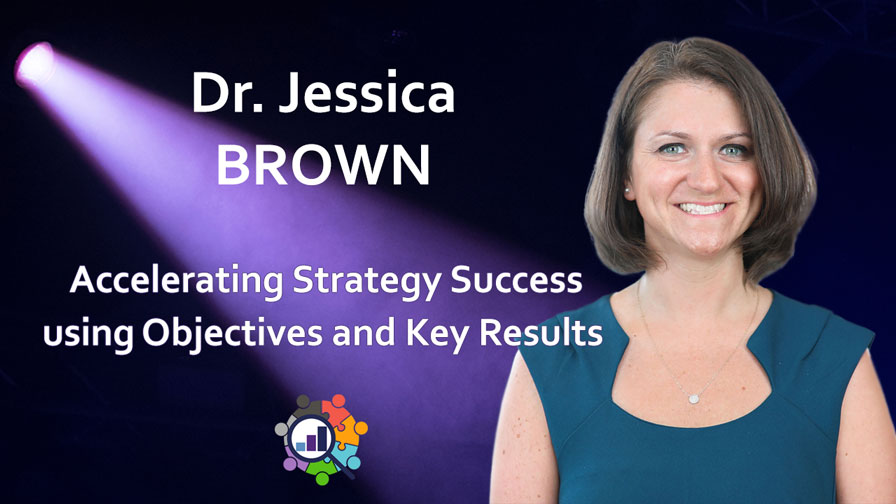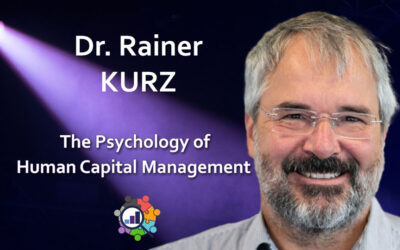A CykoMetrix Spotlight Production
Every week, the Spotlight shines on an amazing professional with a story to tell and lessons to teach. Welcome to the CykoMetrix Spotlight.
The following is an adapted transcript of the exchange between Sylvain Rochon, CMO at CykoMetrix as host, and Dr. Jessica Brown, Organizational and Leadership Development Consultant. www.linkedin.com/in/jessicabrown
Sylvain Rochon: Hello, my name is Sylvain Rochon, I am the Chief Marketing Officer at CykoMetrix, a leading-edge combinatorial, psychometric, and human data analytics company that brings the employee assessment industry to the cloud with instant assessments, in-depth analysis, trait measurements, and team-based reporting features that simplify informed decision-making around recruiting, training, and managing today’s modern workplace.
Today in the Spotlight, we have Dr. Jessica Brown. She is an organizational and leadership development consultant. She has more than ten years of organizational and leadership development experience. Throughout her career, she has worked with all levels, sizes, and industries in the areas of strategic planning, change management, organizational assessment, leadership development, performance, talent, and succession management. Jessica teaches and uses a variety of methodologies in her engagements with objectives and key results, also known as OKRs, and Balanced Scorecard, Situational Leadership and Organizational Excellence. She utilizes assessments of all types to help leaders ensure their current to future states are clear to reach ultimate success. That is a fascinating field. Thank you for being in the Spotlight, Jessica.
Jessica: Thanks for having me. I’m excited to be here.
Sylvain: Now, when we first talked, you introduced me to the concept of OKR — I had never heard the term before. Objectives and Key Results (OKRs). We had a chat. So, why don’t you tell the audience how did you get into this? What is your expertise? What’s your background? Tell us about you.
Jessica: You’ve got it. I mean, everybody likes to understand the story that creates our passion. I’ve always had a passion from a young age growing up with my mom coming home unappreciated from work, I developed a want and a passion for making organizations really great places to work. We do that strongly through having great leadership, great strategy, and great culture. We really think that these three things are the pivotal things that help organizations reach and maintain the success that they want. We know that organizations are just groups of people working together for the same goal. So, to get them all working in the same direction, that’s where strategy really plays a big role. So, unless everyone is clear on where we’re going with the organization this year and the next 5 years, they have no idea how their role contributes and how they can help achieve that. So, I started diving into the realm of helping leaders lead the entire organization and involve the entire organization in that, not only planning but executing process.
Sylvain: Why was this whole concept important to you? Either personally or professionally. Where did the passion come from?
Jessica: Yeah. I mean, again, growing up with a single mom unhappy at work and all of us these days, no matter where you work in the world, you’re still spending the majority of your time working in an organization. So, instead of having organizations and employees come home feeling demotivated and disengaged. Sometimes you’re over-utilized or underutilized and undervalued. We want to help organizations be successful. We want to do it in a way that helps employees thrive and really find their stride and their passion for contributing to the organization.
Sylvain: Okay. So, I’m inferring that it’s something that you found important growing up with a single mom, in your case, right?
Jessica: Yeah. I mean, as a piece but I think that’s where my passion for all organization and leadership development came from. We’ve all worked in an organization for a really great leader and we’ve all worked in an organization for a not-so-great leader. So, how do we get more of the leaders that develop, that hold us accountable in a productive way, that ties us to the big inspiration of the team and organization? Those leaders, you would follow anywhere. Those leaders, you’d stayed even in an organization you might not have stayed in because of that leader in that team.
Sylvain: Right. When we talked about this last time, we discussed how you can accelerate strategy success using those Objectives and Key Results (OKRs). Accelerating implies that there’s a bit of velocity for us, I’m a bit of a scientist so I think this way. Companies have a velocity, they’re moving at a certain speed, but then accelerating means increasing such a speed. So, how specifically do OKRs accelerate success in a company?
Jessica: Sure. So, not only accelerate but also add agility, right? We know that you could push on the gas pedal of a car and go really fast, but we don’t want to do that unless we know the car has great maneuverability and the ability to miss obstacles when the deer comes in the road or a tree falls. We not only want to go fast, but we also want to have the ability to adapt quickly to what’s happening. So, the challenge that we’ve had in past years, organizations started to first see the need for even a future level of planning. So, thinking about where do we want to go in 5 years? That became the normal trend of strategic planning. That was great but then organizations would sit in December and create this year-long plan. Then, it would be a document that sat on the shelf, and maybe at the end of the year, we would ask ourselves, did we achieve some of this or not? So, this is from the fact that we were missing that gap, we know when we implement something like OKRs, like companies like Google, Amazon, LinkedIn, and Spotify — numerous organizations have implemented this — you start to get the strategic plan throughout the organization and are therefore able to achieve more of it throughout the year.
Sylvain: Okay. So, I’m starting to get the picture here. I’m thinking about acceleration, of course. Eventually, you get out of break neck speed, and then possibly fall into issues of organizational health because you may just focus on the objective and you’re careening towards it, but you’re not very flexible with different situations and different conditions and environment, and whatever else that may come up. So, you’re implementing a strategy where the organization must also be flexible to be able to pivot and change in direction. So, this seems to me perhaps some kind of agile process. I’m using that word, but it could be another process. Maybe, a job style?
Jessica: Let me touch on that. Most IT companies are typically doing Agile, which if everyone doesn’t know, it’s more of a 2-week planning cycle cadence. All too often, this 2-weeks is too quick of a planning phase for the rest of the departments in the organization like HR, overall operations, marketing, and sales. So, what OKRs did was take the annual long-term plan, and something like the 2-week completely iterative, fast-moving, and changing plan, and started to meet in the middle and create a quarterly cycle for all departments in the organization. Because again, accelerating is great but if the two of us are running or if we’re marching, we have to be marching at the same speed to get that agility as well. Otherwise, we trip on each other. We get tangled up. We take resources from each other. And so, how do we get that rhythm and agile process, including everyone so that we can change? We know a quarter can change. We were into 2020, March 1st quarter, and all organizational plans for that year were out the window because we didn’t necessarily anticipate something like Covid.
Sylvain: So, OKRs are when you’re consulting at the very least with companies that are modifiable. They should evolve or they are established in a certain period with a certain frequency, is that correct?
Jessica: Great question. So, we know that different levels of the organization have different spans of control, responsibility, and view. So, the time spans, typically what we recommend is at the organizational company level, so the CEO and the C-suite. They are setting the annual plan, they’re setting the long-term view, they’re setting the 5-year plan, and then we’re looking at that and saying, what do we got to get in year one and what direction do we have to communicate to the rest of the organization? Then those lower departments, teams, and individuals are flying at the speed of a quarterly cycle. So, they’re looking at the yearly plan. They’re operating for a quarter, they’re stopping, they’re reflecting, they’re saying how far did we get, now where do we going to get in Q2 to get us to that final finish line of the year? So, we have multiple cycles running simultaneously but in the same rhythm throughout all levels of the organization, that way all teams are synchronized. All teams are aligned with the organizational direction. That’s where we start to see that acceleration, growth, higher performance and more achievement of results and things like that.
Sylvain: So, in your experience, you’ve observed and you work with companies of all sizes in multiple geographies, right? Do you see any differences in adopting such processes in companies of various sizes or even industries or geographies?
Jessica: I think absolutely. Every organization takes OKRs and tailors them slightly to their current processes and how they want to use them. We do always have some best practice recommendations to really get the full benefit out, but we know that all organizations operate differently as well. So, I think it’s not as much location or even size. With size you’re always going to have a challenge with more difficult change management. The more people we have to get on board, the more effort we have to do it in that. But it’s more about the maturity of strategic planning and what I like to call the strategic management process. Again, planning is step 1. We’ve got to be consistently managing this process. So, I think that’s when we know how knowledgeable, how aware are they of their mission? Do they have a clear Mission? Do they have a clear Vision? Do they know where they want to be in 5 years and have very clear metrics to say if they were successful? That helps them make their 1-year plan, and then thus down throughout the rest of the organization.
Sylvain: Well, that’s good to know. Because of this type of method, I know from my own experience as an entrepreneur, it is highly effective. I just didn’t know what it was called. You’re talking about terminology.
Jessica: Here’s the challenge: we know that the concept of strategic planning is a long-term one, a very traditional one. Every new business theorist comes out with a different methodology. OKRs get wrapped up in certain ways because people take it into a methodology only and don’t see it as just how good strategic management is done. So, I mentioned a Balanced Scorecard. When I go and help organizations write objectives… an objective is an intention that you want to shoot for. We’ve all written a New Year’s resolution at some point. So, what was your objective? I wanted to be healthier to live longer. So, I measured that in certain ways. How much water am I drinking a day? How much exercise am I doing? How many calories am I putting in? How many hours of sleep am I getting? So, we all set goals. It’s another goal management or goal-writing system. However, it’s about the implementation of getting a leader to bring their team members into planning so that everyone is involved. And they’re bought into the plan because they help make it. Then, they go down to their teams as leaders participating in another team and they communicate with their team what the bigger team just said, we’re going here. How does our smaller team contribute? So, people get fired up when they see how their role contributes to that 5-year mission and the big picture that the organization’s trying to reach.
Sylvain: I mean, you’re preaching to the choir, sister. I love what you’re saying. I’ve been doing this with my own businesses. I’m in tech and you’re probably aware, tech tends to adapt because our jobs come from technology. So, we tend to be a little bit more on top of such things, but it’s so, so important. The follow-up question would be, okay, so this is amazing. If people are watching this and saying, “oh, I want this. I want to accelerate my strategy and success, as well”. How do they engage with you to get that done?
Jessica: Sure. So, I’m accessible on LinkedIn, but we have all sorts of resources available that we can provide. I’ve been doing strategy through different consulting firms, specifically on OKRs for about 4+ years now. I’m currently working with an organization and doing a full solution. So, we not only help you first learn about the concept and how to implement it. What are the best practices that each team needs to be doing? Then, also there’s a whole wealth now of tracking platforms and leadership management platforms that help you do all the different things that help make us better leaders, including strategy, performance management, growth, feedback, and recognition. All those things get people excited and wanting to stay in your organization. So, that’s what we find really, truly starts to accelerate that performance and that growth.
Sylvain: Awesome. So, multiple resources are better than one. So, what we’ll do is we’ll put down a couple of resources and links in the description of the video and also in the blog, so you guys that are watching can go and explore and go directly to Dr. Jessica Brown’s LinkedIn as well. She’s very responsive on LinkedIn, I know. So just go with the issue you’re trying to solve and she’s going to direct you to the right proper resources from multiple angles from where you come from, she’s going to help you out.
Thank you so much for participating in the Spotlight, Jessica. Illuminating that very important concept of, let’s call it flexible goal setting. OKRs, and how it can be implemented in a variety of ways, customized to the needs of your business. Super important. Thank you so much.
Jessica: You bet. Thank you.
About Dr. Jessica Brown – www.linkedin.com/in/jessicabrown
Dr. Jessica Brown is based in the Washington, DC area and has more than 10 years of organizational and leadership development experience. Throughout her career, she has worked with all levels, sizes, and industries in the areas of strategic planning, change management, organizational assessment, leadership development, and performance, talent, and succession management. Jessica teaches and uses a variety of methodologies in her engagements from OKRs and Balanced Scorecard, to Situational Leadership and Organizational Excellence. She utilizes assessments of all types to help leaders ensure the current to future states are clear to reach ultimate success. She is particularly experienced in the realm of helping companies create and align their organizations from top to bottom to achieve the most effective results. She especially loves animals and being in nature whenever possible.
About CykoMetrix – www.CykoMetrix.com
CykoMetrix is a leading edge combinatorial psychometric and human data analytics company that brings the employee assessment industry to the cloud, with instant assessments, in-depth analysis, trait measurements, and team-based reporting features that simplify informed decision-making around recruiting, training, and managing today’s modern workplace.



